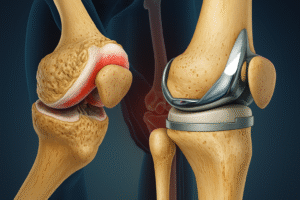Orthopedics is the area of medicine that deals with joints, bones, muscles, ligaments, and tendons. A number of popular surgical procedures in the field of orthopedics nowadays are knee reconstruction surgery. It is performed all over the globe to ease knee pain, improve mobility, and enhance the general health of the patient. Thanks to the latest surgical techniques and modern implants, the procedure has evolved into an extremely safe and highly effective.
In this article, we will learn more about knee replacement, the procedure, what it is, the reason for doing it, and what types of procedures it can be used for recovery, and the way that life is changed after surgery.
What is Knee Replacement Surgery?
Knee replacement, also known as knee arthroplasty, is a procedure in which the damaged components that make up the joint of the knee are replaced by artificial joints known as prostheses. They are made from sturdy metals and medical-grade plastics. They function as a natural knee, aiding in a smoother movement while reducing the pain.
Why is Knee Replacement Needed?
Knee replacement is recommended if other treatments such as medicines, exercise, and lifestyle adjustments aren’t working. The most common ailments are:
-
Osteoarthritis is a result of age-related wear and tear on the joints of the knees.
-
Rheumatoid Arthritis: Joint inflammation caused by changes in the immune system.
-
Post-Traumatic Arthritis: Arthritis that develops after injuries to the knees.
-
Severe Knee Injury: Injuries or deformities that limit the movement.
Patients typically think about surgery at times when:
-
Climbing stairs, walking, or performing everyday activities can cause extreme pain.
-
The stiffness of the knees makes it difficult to move.
-
The pain can affect sleep quality and general quality of life.

Types of Knee Replacement Surgery
-
Total Knee Replacement (TKR)
-
Most popular kind.
-
The knee joint is completely replaced by artificial joints.
-
Gives you long-lasting relief as well as better mobility.
-
-
Partial Knee Replacement (PKR)
-
Only the damaged area of the knee has been repaired.
-
More minimally invasive and faster recovery.
-
It is ideal to use only one side, as your knee can be affected.
-
-
Bilateral Knee Replacement
-
Each knee is replaced at the same time (or in two steps).
-
Patients suffering from joint arthritis.
-
-
Revision Knee Replacement
-
It is done when a knee implant is in need of replacement.
-
More complicated, but it improves knee function.
-
The Surgical Process
-
Preparation
-
Tests such as X-rays, MRIs, and blood tests.
-
Training and physiotherapy for strengthening muscles.
-
Lifestyle and diet recommendations prior to surgery.
-
-
During Surgery
-
The patient is anesthetized.
-
The cartilage and bone that have been damaged are removed.
-
The artificial knee implant is placed with care.
-
The wound is then closed, and the bandage is placed.
-
-
After Surgery
-
Patients can begin walking with help after 24 hours.
-
The typical hospital stay is 3 to 5 days.
-
The physiotherapy process begins earlier to speed up recovery.
-
Recovery and Rehabilitation
-
Initial 2 weeks: Walking aids like crutches or even canes can be utilized. Exercises start under guidance.
-
Two to six weeks. The patients can walk further distances, perform everyday activities, and gain strength.
-
6 weeks after: Most patients can return to their normal lives, which includes driving, exercising, and even working.
-
Long-term, the complete recovery can last anywhere from 6 months to an entire year, but patients experience pain-free movement and enhanced mobility.
Life After Knee Replacement
-
Joint pain relief and improved function.
-
Able to walk easily and carry out daily activities without limitation.
-
Artificial knees can last 15 to 20 years or more with the right maintenance.
-
Activities such as cycling, swimming, and yoga are suggested.
-
Extremely high-impact sports like jumping or running are generally not recommended to protect the new joint.
Modern Advances in Knee Replacement
-
The smallest amount of Invasive Surgery – Smaller cuts, faster recovery.
-
robotic-assisted surgery, high-precision for implant positioning.
-
Computing Navigation better alignment and longer-lasting results.
-
Individualized implants customized to the specific body shape of each patient.
-
High-Performance Materials The HTML0 is stronger and lasts longer in prostheses.
Conclusion
Knee replacement is not an operation; it is a method to give patients a fresh outlook on life. People who had previously suffered from limitations in mobility and pain are now able to walk, climb stairs, and take part in their favorite activities once more. With advances in medical technology, the rate of success is high, and the speed of recovery is greater than ever before.
If knee pain is impacting your daily activities, consulting an orthopedic doctor can be the initial step to recovering your independence and enjoying an uninhibited future. The knee replacement can be a huge help in improving flexibility, confidence, and the quality of life.

